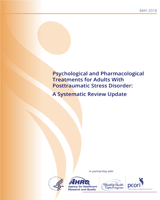Criterion A: Traumatic event that involved:
actual or threatened death,
serious injury, OR
threat to physical integrity
AND
Intense response of fear, helplessness, or horror | Criterion A: Traumatic event as defined by:
direct exposure to,
witnessing indirectly (by learning a close friend or close relative was exposed), OR
repeated/extreme indirect exposure in the course of professional job (not through media) | Changes to wording of traumatic event exposure specification
DROPPED Intense
response of fear, helplessness, or horror criterion |
Criterion B: Re-experiencing symptoms (1 or more):
Intrusive recollections of events
Recurrent distressing dreams of the event
Acting or feeling as if the traumatic event were recurring
Distress at internal or external reminders of the trauma
Physiological reaction to internal or external reminders | Criterion B: Intrusion symptoms (1 or more):
Recurrent, intrusive memories
Traumatic nightmares
Flashbacks
Intense/prolonged distress after exposure
Physiological reactivity upon exposure to cues | New title of criterion
Changes to wording of criterion |
Criterion C: Persistent avoidance and numbing (3 or more):
Avoidance of thoughts, feelings, or conversations associated with trauma
Avoidance of activities, places, or people that arouse recollections of trauma
Failure to recall an important aspect of trauma
Loss of interest or participation in significant activities
Detachment from others
Restricted range of affect
Lost sense of the future | Criterion C: Persistent effortful avoidance of distressing trauma-related stimuli (1 or more):
Trauma-related thoughts/feelings
Trauma-related external reminders
Criterion D: Negative cognitions/mood (2 of 7)
Inability to recall key features of the trauma
Negative beliefs about oneself, the world
Distorted blame of self, others
Persistent negative trauma-related emotions
Diminished interest
Feeling alienated, detachment/estrangement
Constricted affect | Split avoidance and negative sequelae into 2 criteria
Changes to wording of specific criterion |
Criterion D: Hyperarousal (2 or more):
Difficulty falling or staying asleep
Irritability or outburst of anger
Difficulty concentrating
Hypervigilance
Exaggerated startle response | Criterion E: Alterations in arousal and reactivity (2 or more):
Irritable or aggressive behavior
Self-destructive/reckless behavior
Hypervigilance
Exaggerated startle response
Problems in concentration
Sleep disturbance | New title of criterion
Changes to wording of criterion
Added self-destructive/reckless behavior |
Criterion E: Duration of disturbance
Duration of disturbance symptoms is more than 1 month | Criterion F: Duration of disturbance
Duration of disturbance symptoms is more than 1 month | None |
Criterion F: Clinically significant distress or impairment
Duration of disturbance symptoms is more than 1 month | Criterion G: Clinically significant distress or impairment
Duration of disturbance symptoms is more than 1 month | None |
Criterion G: Exclusion criteria
Symptoms are not due to medication, substance use, or other illness | Criterion H: Exclusion criteria
Symptoms are not due to medication, substance use, or other illness | None |
